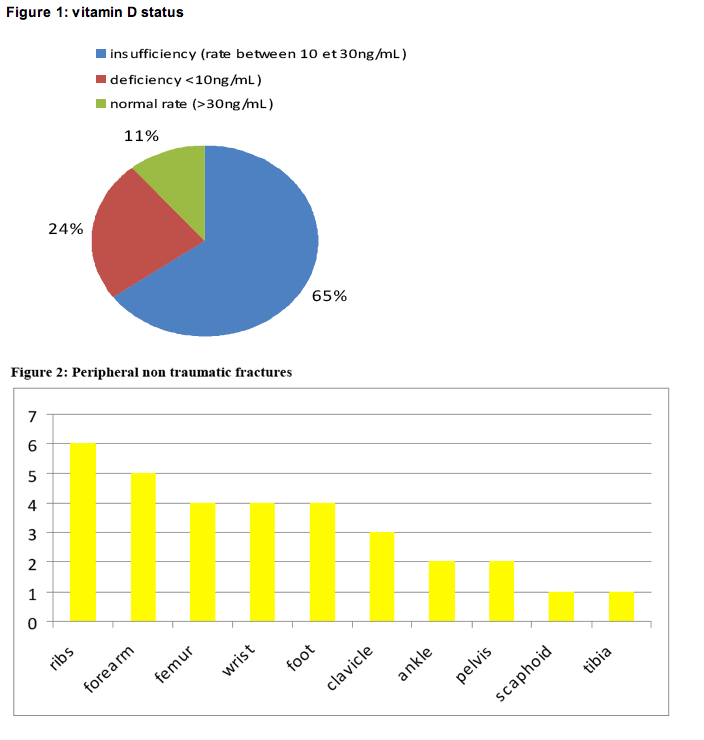 |
 |
 |
| |
BONE STATUS ASSESSMENT IN HIV-INFECTED PATIENTS : AN OBSERVATIONAL STUDY OF 199 PATIENTS
|
| |
| |
Reported by Jules Levin
52nd ICAAC Sept 9-12 2012 SF
L. Lemeunier1, N. Viget2, E. Biver1, B. Cortet1, E. Senneville2
1Department of rhumatology, CHRU, Lille, France ;
2Department of Infectious diseases, CH, Tourcoing, France
CONCLUSIONS
The results of the present study suggest a high prevalence of osteopenia and osteoporosis in HIV-infected patients in accordance with
those of previous studies (3 to 22 %, and 23 to 65 % for osteopenia and osteoporosis respectively) [2,3,4].
We did not find, as previouly reported, any association between tenofovir treatment and low bone mineral density in our population.
Only age and BMI were significantly associated with both osteopenia and osteoporosis.
CD4 rate might rather be related to fracture risk assessment, probably due to other confounding factors.
Introduction
Development of HIV antiretroviral therapies (ART) has considerably improved HIV-infected patients condition but is associated with
many metabolic side effects, and notably on bone [1].
A decrease in bone mineral density (BMD) has been reported in many studies in patients treated with ART, with wide ranges of
prevalence of osteopenia and osteoporosis [2,3,4].
A multifactorial origin seems implied, with osteoporosis risk factors, the role of HIV infection itself and the ART treatments
Patients & Methods
We conducted a monocentric retrospective study between March 2005 and July 2011, collecting the data from 199 HIV-infected patients (148 men and 51 women), aged of 46.8▒11.3 years, who had a DEXA assessment at 3 sites (femoral neck, total hip and lumbar spine) as part of their follow-up.
At the date of BMD, osteoporosis risk factors*, co-infection with VHC, CD4 rate, viral load, vitamin D status, ART, and cumulative
duration of treatment were collected.
*Osteoporosis risk factors : body mass index (BMI), family or personal history of fracture, smoking or alcohol habits, corticosteroids > 7,5mg/day for three months or more, endocrinopathy (hyperthyroidism, hypogonadism).
RESULTS
32 men (21.6 %) and 8 women (15.7 %) had osteoporosis whereas 70 men (47.3 %) and 20 women (39.2 %) had osteopenia.
Osteoporosis was predominantly reported at the femoral neck in both genders.
Only older age (p<0.01), and lower BMI (p<0.001) were significantly different between osteoporotic and non osteoporotic patients.
No difference was found concerning smoking and alcohol habits, VHC-coinfection, duration of HIV infection, CD4 rate, viral load,
lipodystrophy, fracture history, duration of exposure to each ART class (nucleoside reverse transcriptase inhibitors (NRTI) with or
without tenofovir ; non nucleoside reverse transcriptase inhibitor (NNRTI); protease inhibitors (PI), and vitamin D status. (table 1).
In simple regression analysis, femoral neck BMD was significantly associated with age, BMI and NRTI treatment duration without
tenofovir. BMI was the unique parameter significantly associated to both total hip and lumbar spine BMD.
Multiple regression analyses showed that age and BMI explained 20.8 % of BMD variability at the femoral neck (p< 0.001), BMI by
itself 10.1% of BMD variability at the total hip (p<0.001) and finally, BMI and the duration of treatment with tenofovir 7.1 % of BMD
variability at the spine (p<0.001).

A high prevalence of vitamin D insufficiency was found in our population of patients (figure 1).
37 patients (18.6%) with a history of fracture were identified, including 3 with vertebral localization.
The different types of non-traumatic peripheral fractures are shown in figure 2.
Lower CD4 rate was the unique parameter associated with a history of fractures after adjustment for age and BMI (p=0.031).
The search *of a secondary origin of osteoporosis was conducted for each case of diagnosed osteoporosis. An etiology of
secondary osteoporosis was found in only 5 patients (12.5%) [ Fanconi syndrom linked to the use of tenofovir (n=1), primitive
hyperparathyroidism (n=1), hemochromatosis (n=1), and hypogonadism (n=1)].
*dosage serum of calcium, phosphate, iron, hormones (cortisol, testosteron) 25OHVitamin D, parathyroid hormon, protein
electrophoresis ; dosage urinary proteins, calcium et phosphate

References
[1] Katlama C. VIH: complications et comorbiditÚs John Libbey 2009.
[2] Paccou J, Viget N, Legrout-Gerot I, Yazdanpanah Y, Cortet B. Bone loss in patients with HIV infection. Joint Bone Spine 2009 ;76:637-41.
[3] Landonio S, Quirino T, Bonfanti P, Gabris A, Boccassini L, Gulisano C, et al. Osteopenia and osteoporosis in HIV+ patients, untreated or receiving HAART.
Biomed Pharmacother 2004 ;58:505-8.
[4] Cazanave C, Dupon M, Lavignolle-Aurillac V, Barthe N, Lawson-Ayayi S, Mehsen N, et al. Reduced bone mineral density in HIV-infected patients:
prevalence and associated factors. AIDS 2008 ;22:395-402.
|
| |
|
 |
 |
|
|